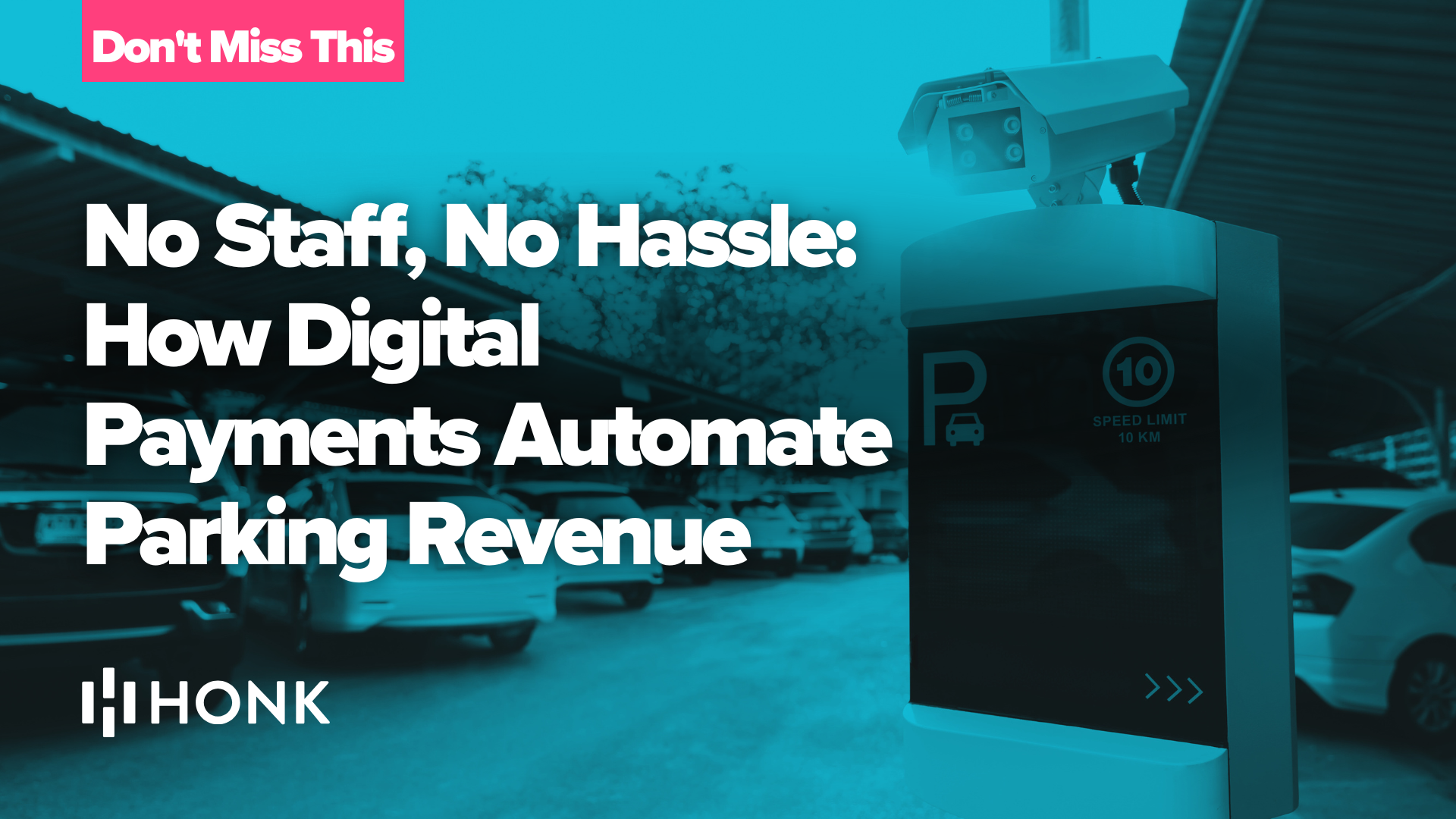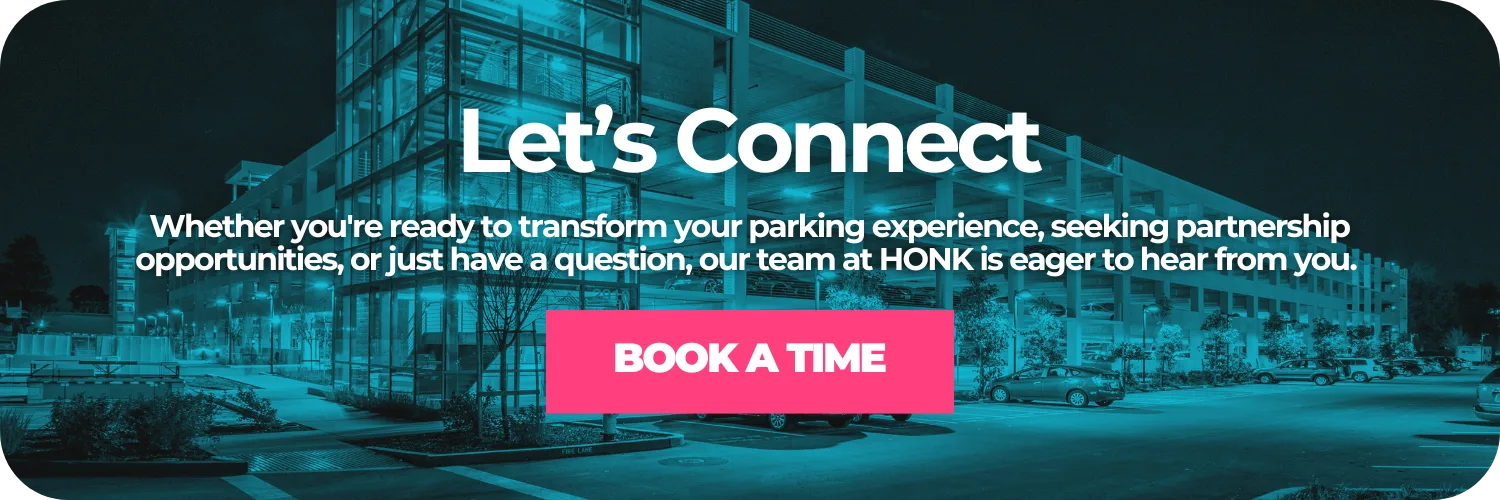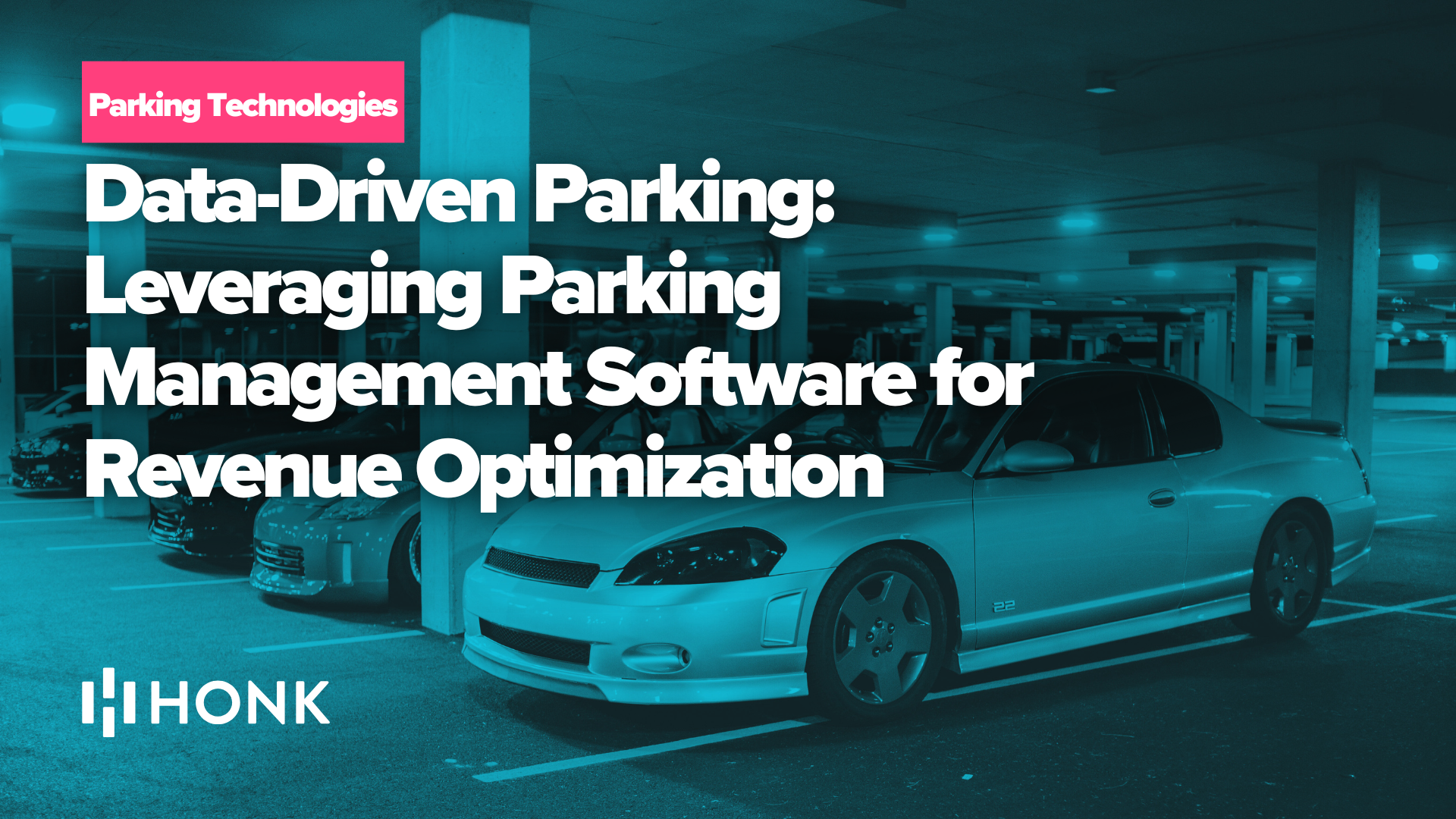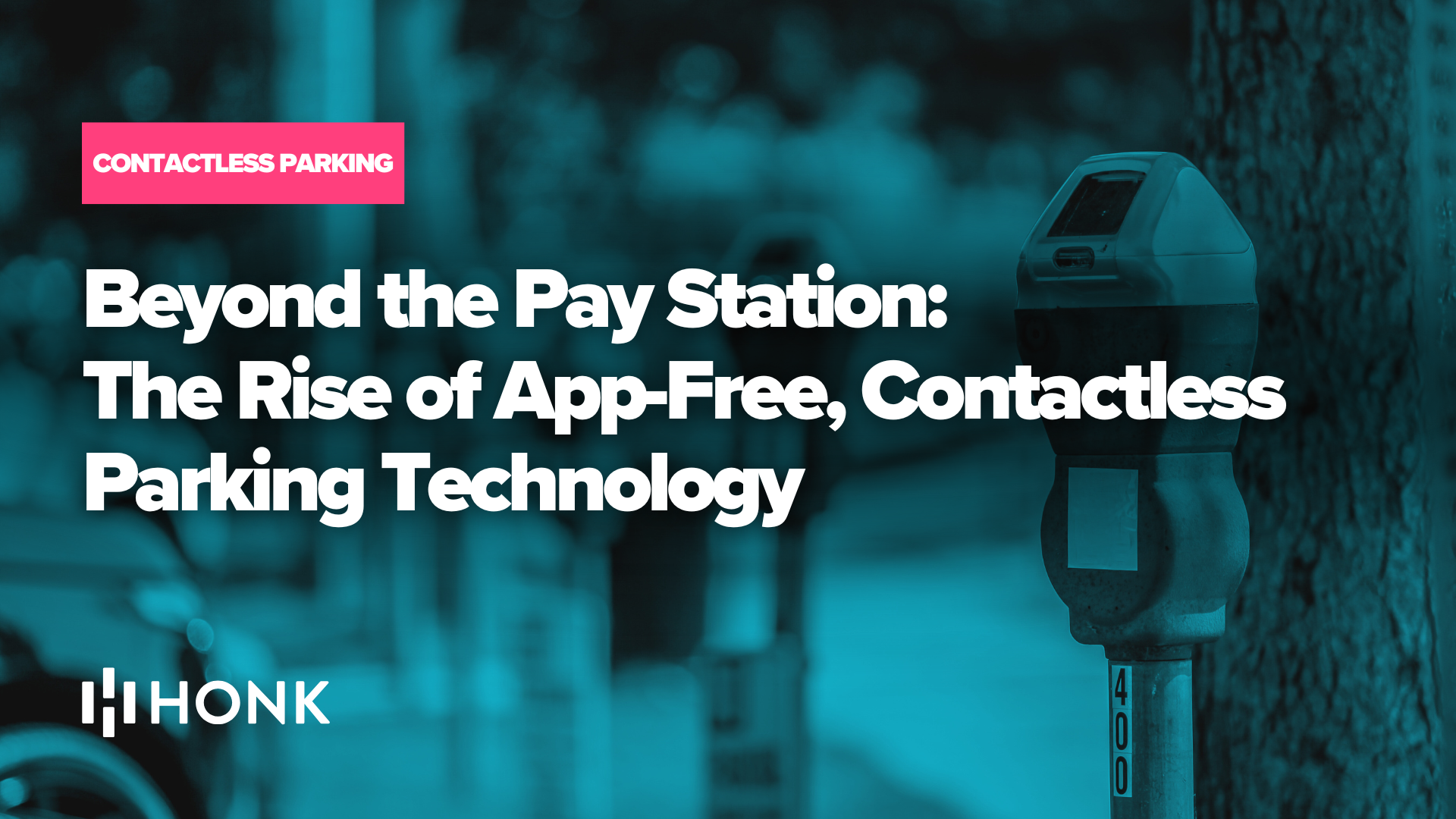Parking operations are undergoing a digital transformation. Gone are the days of cash boxes, paper tickets, and slow manual processes. Forward-thinking parking operators are embracing mobile-first, contactless payment systems to streamline their business and boost the bottom line. In fact, operators who modernize their payment systems have seen a 15–20% increase in daily transactions after going digital. The global momentum is clear: the smart parking market is projected to grow from $8.5 billion in 2023 to $48.3 billion by 2033, driven in part by the rise of cashless payment systems and mobile app integration. This blog post explores how HONK – a leading digital parking platform – leverages contactless payments, cloud-based parking management software, real-time analytics, and license plate recognition to automate operations, increase parking revenue, reduce costs, and improve the parker experience.
Contactless, Mobile-First Parking Payments: The New Standard
Consumers today expect convenience and speed in every transaction – and parking is no exception. A vast majority of drivers (around 80%) say they prefer digital payment options for parking It’s easy to see why. With contactless parking technology like mobile apps, QR code scans, and tap-to-pay, paying for parking becomes a frictionless experience. Drivers can simply use a smartphone or contactless card instead of fumbling for coins or waiting in line at a meter. Visa reports that 74% of consumers prefer contactless payments because they’re faster and more convenient. During the COVID-19 pandemic, these touchless parking payments also proved safer – nearly 46% of consumers said contactless payments are among the most important safety measures businesses can offer. A mobile-first approach: Drivers can simply scan a QR code with the HONK app or their phone camera to pay for parking, enabling a completely contactless payment experience on the spot.
For parking operators, adopting a mobile-first parking strategy means meeting modern customer expectations and casting a wider net of potential parkers. By offering multiple contactless parking payment options – from the HONK mobile app to Apple Pay, Google Pay, QR codes, and even license plate recognition – operators remove barriers to payment. This inclusivity attracts more customers and improves compliance. When drivers have easy, touch-free ways to pay, they’re less likely to seek free parking or risk not paying at all. The result? Higher parking occupancy and revenue. In fact, providing diverse, convenient payment methods has been shown to directly boost parking customer satisfaction and loyalty, leading to repeat usage and positive word-of-mouth. Put simply, seamless parking payments create happier customers and healthier revenue streams
.
Streamlining Operations with Cloud-Based Parking Management Software
Digital parking solutions do more than delight customers – they also streamline parking operations behind the scenes. By moving to a cloud-based parking management platform like HONK, parking operators can automate and simplify administration that once ate up hours of staff time. Consider cash handling: counting money, maintaining meters, reconciling accounts, and preventing theft. Studies show that handling physical cash can cost businesses roughly 9.1% of the cash collected in operational overhead. Those are dollars lost to labor, shrinkage, and bank fees. Digital payment processing cuts out these inefficiencies. There’s no need to empty meters or manually log transactions – payments go straight from a driver’s phone to the cloud, with automatic records in the back office.
Automation also means parking staff can be reallocated to higher-value tasks. Fewer on-site staff are needed to handle payments, which can cut labor costs by 20–30% for parking operators. Instead of stationing attendants to collect fees or fix jammed ticket machines, operators can rely on software to do the heavy lifting. Parking operations software like HONK’s gives managers a real-time dashboard of their facilities, accessible from anywhere. They can monitor transactions, occupancy, and alerts remotely (remote parking monitoring), without constant site visits. Daily tasks like issuing permits, verifying payments, or generating reports are handled digitally with just a few clicks. This level of parking management automation streamlines parking administration drastically – one person can oversee many locations through a single parking operator platform. For example, Winnipeg’s parking authority went virtually cashless and reported significant reductions in collection time and maintenance, freeing up staff for other priorities.
Crucially, shifting to software-based systems eliminates much of the physical infrastructure and maintenance that older parking systems require. There’s no expensive hardware to install at every lot for new payment methods – just signage and an internet connection. As a result, scaling up is painless. Whether you manage 20 spaces or 2,000, a cloud-based parking management solution can expand without costly new machines. “No additional infrastructure is required to accommodate growth. As your facility expands or demand increases, the system simply adapts,” HONK notes about its scalable approach. This flexible parking system model lets even smaller operators adopt smart parking solutions without huge upfront investment. (And if you do need to add hardware like sensors or cameras, open integrations make it plug-and-play – more on that shortly.)
Real-Time Analytics for Parking Revenue Optimization
One of the most powerful advantages of going digital is the data. Every mobile payment, session, and parking event generates information that can be used to optimize your operation. With traditional cash boxes, you might collect coins and have no idea which hours were busiest or how long people stayed. In contrast, a modern parking data management system provides real-time parking analytics at your fingertips. HONK’s platform, for instance, includes business intelligence tools that display occupancy, revenue, and usage patterns as they happen.
Parking management software provides a rich dashboard of real-time analytics – from transaction totals to peak occupancy times – empowering data-driven decisions for parking operators.
By harnessing these insights, operators can practice true parking revenue management. You can identify trends like an increase in evening parkers or a Monday morning lull, and adjust strategies accordingly. Dynamic parking pricing becomes feasible – raising rates during peak demand and offering discounts during off-peak times to maximize parking occupancy and profitability. In fact, data-driven approaches allow a form of parking yield management similar to airlines or hotels. The payoff can be substantial: smart parking operators who leverage real-time data to adjust pricing and optimize space usage have increased revenue by up to 20%. Even simply knowing your peak hours can inform better staffing and enforcement schedules, ensuring no revenue is lost due to missed violations or full lots turning away customers.
Analytics also help with parking space optimization and planning. By analyzing occupancy heatmaps and turnover rates, you might discover underutilized areas or times when demand exceeds supply. These insights could lead to re-striping lots, changing layouts, or introducing valet or reservation options to maximize parking capacity. For example, one digital parking provider found that modernizing payments allowed operators to oversell permit lots by 10–20% based on data, safely increasing utilization without frustrating parkers. The data also feeds into parking financial analytics – robust reports on revenue per day, per space, per location, etc., which make budgeting and forecasting far more accurate. Instead of guesses, you have numbers to support decisions.
The HONK platform integrates parking analytics and reporting into its dashboard, giving operators a clear view of their parking revenue optimization in action. Some operators even set up automated alerts and automated parking reporting – for instance, a daily email that summarizes key metrics or flags anomalies. With real-time and historical data in hand, you can continuously refine your pricing strategies, promotional offers, and staffing to increase parking profitability over time. It’s a virtuous cycle: data leads to actions that generate more revenue and better service, which in turn produces more data to fine-tune your operation further.
Parking Access Control and License Plate Recognition (LPR) Integration
Another game-changer in digital parking systems is the integration of parking access control technologies like Automatic License Plate Recognition (ALPR). License plate recognition uses cameras and AI-powered OCR to identify vehicles as they enter or exit a facility. When combined with a payment platform, LPR enables gateless, ticketless parking – truly frictionless parking from entry to exit. Imagine drivers pulling into a lot and having their plate automatically recognized; if they’ve paid via mobile or have a permit on file, the system instantly validates them. No stopping at a gate or fumbling with tickets. It’s the ultimate touchless parking experience.
For parking operators, LPR integration means streamlined parking enforcement and access management. HONK’s system, for example, is designed to be platform-agnostic and connects with virtually any third-party enforcement software or LPR hardware via open API. When a driver pays through the HONK app or any HONK-powered payment station, the system can immediately push that data to the enforcement platform, marking that vehicle as paid. Enforcement officers using systems like Gtechna, T2, or Genetec can see which license plates are compliant in real time, even if they are using their existing parking enforcement software. This third-party parking integration eliminates manual cross-checking – citations can be issued only when necessary, and compliance can be monitored efficiently through software.
License Plate Recognition also opens the door to new revenue opportunities and conveniences. Some parking operators use LPR to offer gateless entry and exit in garages: cameras log when a car enters and leaves, and the system calculates the duration and charges the customer’s mobile payment method automatically upon exit (often called “drive in, drive out” or frictionless parking). This provides a VIP-like experience to the parker and ensures accurate fee collection down to the minute – a clear win for parking monetization. LPR can even facilitate parking enforcement automation like automatic ticketing for overtime or unauthorized vehicles, with photographic evidence. Overall, integrating LPR into a parking operator platform brings greater control and security with less labor. It also enhances customer trust that the system is accurate and fair (no more disputes about lost tickets or whether you paid – your plate is your permit).
Moreover, modern parking software solutions like HONK allow you to manage these integrations centrally. The platform can serve as the hub for various components: mobile payments, LPR cameras, parking access control gates (if you still use gates), sensor data, and more. A connected parking technology ecosystem means everything “talks” to everything else – your parking data management unifies payment data with vehicle identification data. This not only helps enforce compliance but can provide insights like repeat visitors (via license plate logs) or assist in parking space availability systems (e.g. showing drivers where open spots are, if sensors or cameras detect empties). It’s a step toward the IoT parking solutions of the future, where an array of connected devices and software optimize every aspect of the parking experience.
Reduced Costs and Greater Efficiency (Better ROI)
Digital parking payments and automation don’t just increase revenue – they also reduce parking overhead and operating costs for a double benefit to the bottom line. We’ve already discussed how labor expenses drop when you automate payment collection and enforcement. But there are additional cost savings that parking operators are seeing as they go digital:
- Lower Infrastructure and Maintenance Costs: Traditional parking systems often require costly machines (pay-and-display kiosks, gate arms, ticket dispensers) that have to be installed, powered, routinely serviced, and eventually replaced. By contrast, mobile parking management relies on ubiquitous technology (smartphones and cloud software) with minimal on-site equipment. Operators save on hardware procurement and ongoing maintenance contracts. One municipality noted huge savings by eliminating hundreds of standalone meters in favor of a centralized parking app integration and a few strategically placed signs.
- Reduced Revenue Leakage and Fraud: Digital parking solutions drastically cut down on lost tickets, malfunctioning meters, and employee skimming – all sources of revenue leakage. Every transaction is electronically logged and traceable. And with no cash on site, the risk of theft or vandalism drops. (Nearly half of parking-related theft incidents involve cash transactions, which disappear when you go cashless.) The increased transparency means parking revenue management is tighter; you keep more of what you earn.
- Faster Settlements and Cash Flow: With modern parking payment processing, operators get their money faster. Instead of waiting to collect and deposit cash or sending invoices to monthly parkers, funds from digital payments can be settled to your account almost immediately. The latest parking management software even guarantees next-business-day deposit of funds. Accelerated cash flow improves your ability to reinvest in operations or simply earns you more interest compared to money sitting in a meter.
- Efficient Use of Staff and Resources: By automating routine tasks (like payment collection, report generation, or permit checks), operators can run leaner. Staff can be reassigned from tollbooth duty to patrolling for safety or maintaining facility cleanliness – activities that improve the overall service quality and customer experience. Some organizations have been able to manage remote parking lots without any on-site attendants at all, using just signage, the HONK app, and periodic enforcement sweeps. This can dramatically reduce parking costs in terms of salaries and benefits.
All these efficiencies contribute to a stronger return on investment (ROI) for digital systems. While there is an upfront cost to implementing new technology, many operators find that the system pays for itself quickly through increased revenue and decreased costs. In other words, the move to a digital, automated parking system isn’t just about making operations easier – it makes solid financial sense. Parking is a business, and like any business, if you can raise income while lowering expenses, you improve profitability. A mobile-first payment platform like HONK helps you do both simultaneously.
Happier Parkers, Higher Satisfaction and Loyalty
It’s often said that a positive customer experience leads to repeat business. Parking may be a “grudge purchase” for many drivers, but making it easy and stress-free can turn first-time visitors into loyal customers. Digital parking payments have a direct impact on the parker experience. No one enjoys circling a lot looking for pay machines or rushing back to extend time. With a mobile solution, the customer can handle everything from their phone – find a spot, pay in seconds, receive reminders, and even extend their parking remotely if their lunch runs long. This level of convenience was unheard of a decade ago, yet today’s parkers increasingly expect it.
The result of these user-friendly parking solutions is tangible: facilities that implement well-designed digital payment systems see customer satisfaction rates about 30% higher than those using older methods. When parkers can breeze in and out without hassle, they perceive the facility – and by extension the operator or city – more favorably. This boosts parking customer satisfaction scores and often translates to more business as satisfied users choose your lot again next time (or recommend it to others). Parking customer loyalty is especially crucial in competitive urban areas where drivers have multiple options. A seamless experience enabled by the HONK app or easy-to-use parking platform can be a deciding factor for which garage a driver pulls into.
Convenience features also enhance the experience. For example, the HONK mobile app not only processes payments but can send push notifications before a session expires, letting the user extend time with one tap. It can guide users with GPS to the lot entrance or show parking space availability if integrated with sensors. Some mobile parking platforms (HONK included) even support parking validations and discounts digitally – a shopper could get a validation code from a retailer to apply in-app, no paper validation needed. All these little touches contribute to a frictionless parking journey that feels modern and considerate of the customer’s time.
Improving the parker experience doesn’t just make customers happy in the moment – it feeds back into your revenue optimization. Satisfied customers are more likely to park longer (since extending is easy), try new services like reservations or premium options, and generally view parking as less of a pain. They also complain less to staff, freeing your team to focus on operations rather than appeasing frustrated patrons. Over time, an operator may build a reputation for parking convenience solutions – and in a world where drivers talk (and leave reviews on Google and Yelp), that reputation can attract more business. In short, improve parker experience, and revenue often follows. It’s all part of a holistic approach to parking operations software: not just enforcing rules and collecting fees, but delivering a service that people don’t dread using.
Versatile Solutions for Every Parking Environment
Every parking operation is unique – a downtown municipal garage has different needs than a university campus or a hospital lot. One of the strengths of HONK’s parking software solutions is its flexibility to adapt to various environments and scales. Whether you manage a commercial parking garage, a municipal parking program, or event parking management for a stadium, the same core platform can be configured to fit. This versatility is critical, because it means you don’t need separate systems for each property or use case; one parking management platform can handle them all with customizable rules and integrations.
Consider the range of sectors that benefit from smart parking solutions today: City governments are embracing municipal parking solutions that let drivers pay by app or text, reducing the city’s costs and improving compliance. Universities and colleges use mobile parking management for their campuses, allowing students and faculty to purchase permits or hourly parking through their phones (no more long lines at the parking office on semester start). Airport parking solutions are using mobile payments and LPR to speed up entry/exit for travelers, while event venues and stadium parking leverage digital pre-booking and cashless payments to handle surges on game day. In the private sector, commercial real estate parking operators at office buildings, shopping malls, and retail parking solutions are deploying cloud-based systems to manage tenant parking and visitor validation seamlessly. Even healthcare institutions have turned to hospital parking management apps to reduce stress for patients and visitors finding parking. And let’s not forget residential parking management in condos and apartments, where digital systems are used to manage guest parking, enforce permits, and maximize the use of limited space.
In each of these scenarios, the goals are similar: streamline parking operations, increase parking revenue, and improve the user experience. A robust platform like HONK acts as a parking management partner that can be tailored to each client’s needs. For example, a university might integrate student databases for permit verification, while a municipality might integrate with citation management systems or parking compliance software for city enforcement. A shopping center might focus on validations and loyalty integration, whereas an airport might prioritize parking capacity management and guidance to open spots. The HONK system’s open API and third-party parking compatibility make these customizations possible, ensuring the technology integrates with your parking management rather than forcing you into a one-size-fits-all box.
Scalability is also key. As noted, cloud platforms enable easy parking deployment across many locations without heavy infrastructure. It’s equally straightforward to start with one lot and expand to hundreds – the software scales up, and you simply add more digital payment points (signs, codes, etc.) as needed. This scalability is why even cities and campus systems with tens of thousands of parking spaces can run on HONK’s reliable parking software just as smoothly as a private lot with 50 spaces. Upgrading or migrating from an older system is also simplified by a capable vendor; HONK’s team, for instance, works closely with clients to ensure parking software migration goes smoothly, including porting over data and ensuring parking software compatibility with any existing tools. The end result is a future-proof solution: as new technologies emerge – be it AI parking technology for predictive analytics or new forms of mobile payment – a cloud-based platform can adopt and integrate them, keeping your operation on the cutting edge.
It’s worth noting that many smart city parking management initiatives choose such flexible, digital platforms because they support broader city goals. By optimizing parking, cities can reduce traffic congestion (less circling for spots), cut emissions (vehicles spend less time idling/searching), and even encourage multimodal transportation by managing pricing. According to Allied Market Research, real-time parking management powered by mobile apps and IoT sensors can reduce congestion, fuel consumption, and emissions while optimizing urban space usage. In this sense, parking digital transformation isn’t just good for business – it contributes to more sustainable parking solutions and smarter cities overall.
Driving Parking Business Growth with Innovation
The parking industry is rapidly evolving, and digital payments are at the heart of this evolution. For parking operators and managers, adopting a mobile-first parking management approach is no longer just a tech upgrade – it’s a strategic move to drive parking business growth. By implementing a solution like HONK’s, operators gain a comprehensive toolkit: an easy-to-use parking platform for customers, powerful back-end parking operator tools for staff, and data-driven intelligence for decision-makers. The results speak for themselves in the form of higher revenues, lower costs, and happier customers.
In this friendly digital age, convenience is king. People appreciate when parking is made easy, and they reward it with repeat business and loyalty. Meanwhile, operators enjoy the peace of mind that comes with real-time visibility into their operations and the flexibility to make changes on the fly. It’s a true win-win. By partnering with a trusted parking technology provider like HONK, even traditionally small or old-school parking operations can leap into modernity overnight. The technology is scalable, reliable, and customizable – a recipe for long-term success in a competitive landscape.
As you consider the next steps for your parking operation, reflect on the benefits that digital parking solutions bring: streamlined processes, optimized parking revenue management, automated enforcement, and satisfied parkers. These are not just buzzwords but proven outcomes observed in real deployments across airports, universities, hospitals, municipalities, and commercial lots. The parking innovation solutions available today make it easier than ever to modernize. Don’t let outdated meters and manual methods hold your business back or leave money on the table. The tools to increase parking revenue and improve parking profitability are accessible and user-approved.
The shift to contactless, cloud-based parking management isn’t just about technology for technology’s sake – it’s about improving every facet of parking operations. From the moment a driver enters your facility to the moment you tally up the day’s earnings, digital automation can elevate the experience and outcomes for all involved. Parking may have been seen as a simple commodity in the past, but with the right platform it becomes a strategic asset – one that can be optimized, analyzed, and grown like any modern business. Now is the time to embrace this parking digital revolution. By doing so, you’ll position your organization at the forefront of the industry, ready to reap the rewards of efficiency, profitability, and customer goodwill for years to come. Tap, pay, and done – the future of parking is here, and it’s bright for those ready to honk for innovation.





